AWM41 972 - [Nurses Narratives] Sister Mary G Dwyer
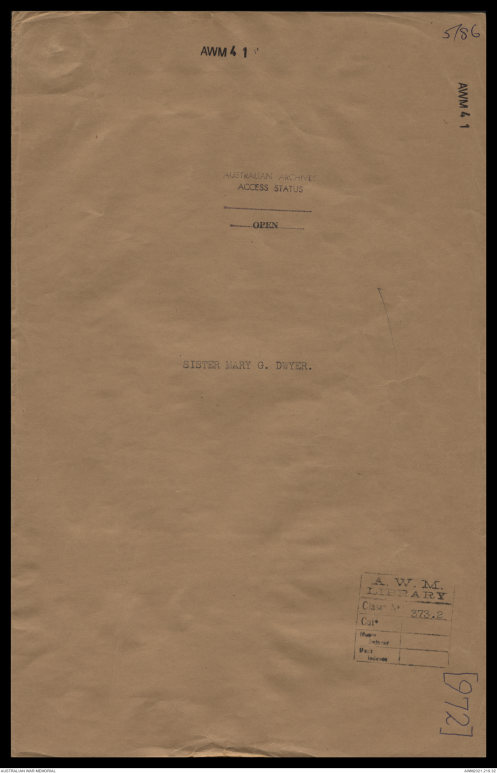
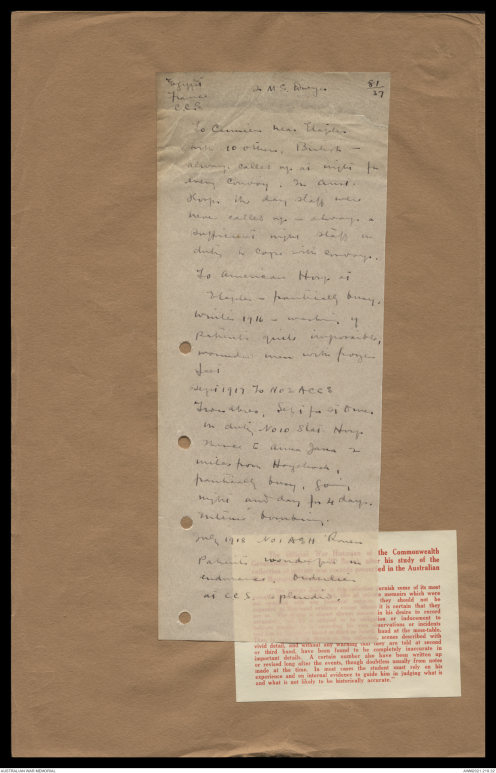
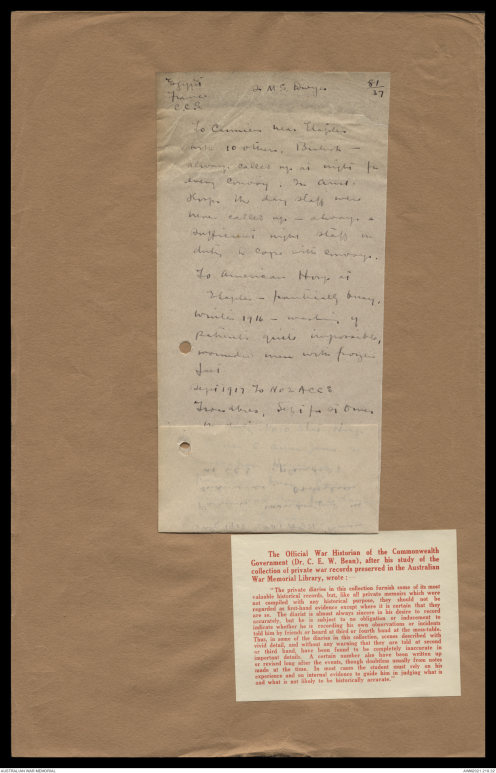
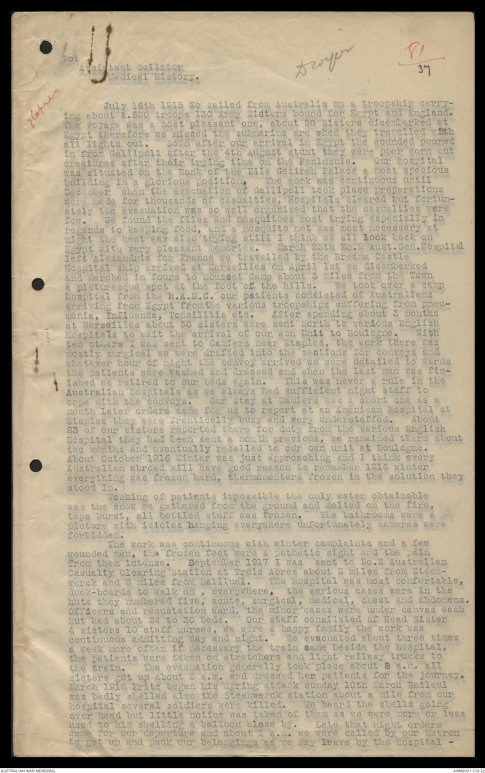
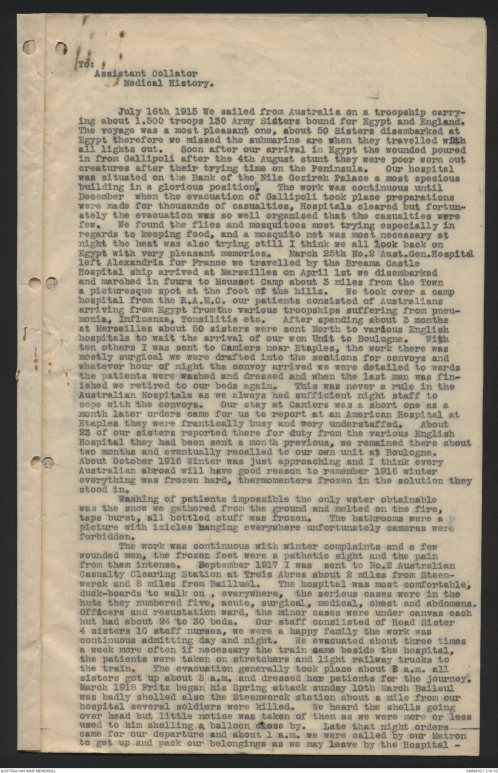
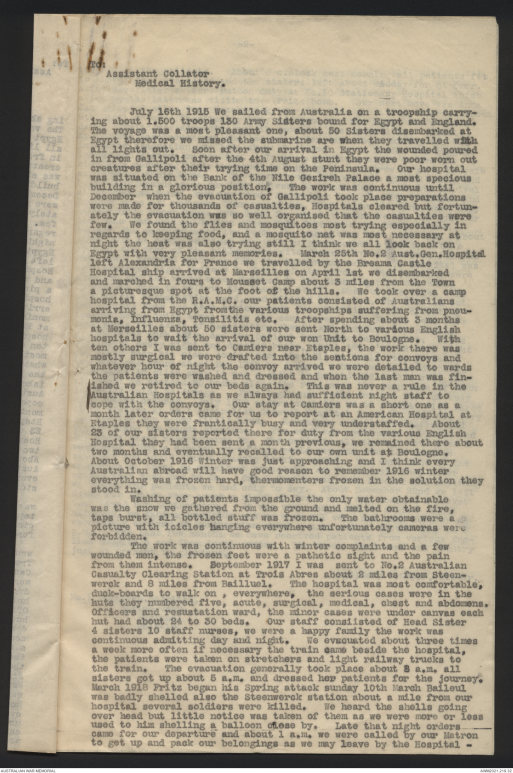
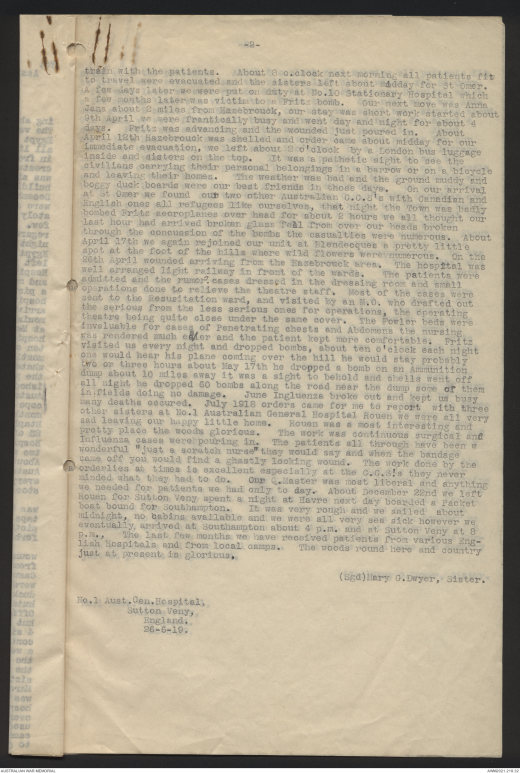

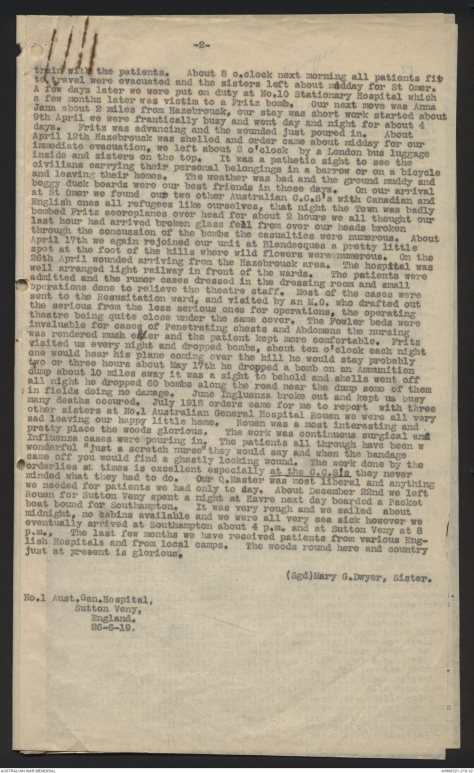
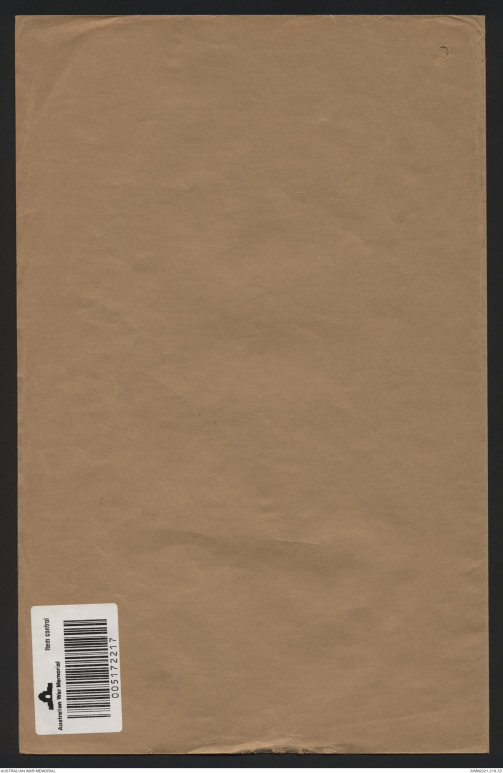
5/86
AWM 4 1
AWM 4 1
AUSTRALIAN ARCHIVE
ACCESS STATUS
—————————
OPEN
—————————
SISTER MARY G. DWYER.
A.W.M
LIBRARY (STAMP)
CASE No 373.2
[[?]]
[[?]]
[[?]]
[972]
Egypt 81
France 27
C.C.R.
Sr M. G. Dwyer.
To Camiers near Etaples
[[?]] 10 others, [[?]] -
always called [[?]] at night for
every Convoy. In Aust.
Hosp. the day staff [[?]]
ever called [[?]] - change
[[?]] night staff on
duty to cope with Convoys.
To American Hosp. in
Etaples - practically busy
[[?]] 1916 - washing of
patients quite impossible,
wounded men with frozen
Jaw.
[[?]] 1917 To No 2 A.C.C.S.
From [[?]], [[?]] [[?]] for [[?]] [[?]].
in duty No 10 Star Hosp.
Moved to Anna Jane 2
miles from Hoysbrook,
[[?]] busy, [[?]]
night and day for 4 days.
[[?minimum?]] bombing.
[[?]] 1918 No 1 A.S.H. Roeun
patients [[?Monday?]] [[?]] in
[[?]] Ordrlies
at C.C.S. splendid.
The Official War Histories of the Commonwealth
Government (Dr. C. E. W. Bean), after his study of the
collections of private war records preserved in the Australian
War Memorial Library, wrote:-
The private diaries in this collection furnish some of its most
valuable historical records, but, like all private souvenirs which were
not compiled with any historical purpose they should not be
regarded as first-hand evidence except where it is certain that they
are so. The diarist is almost always sincere in his desire to record
accurately, but for a subject to no obligation or inforcement to
indicate whether he is recording his own observations or incidents
told him by friends, or heard as third or fourth hand at the mess-table.
Thus, in some of the diaries in this collection, events described with
vivid detail, and without any warning that they are told as second
or third hand, have been found to be completely inaccurate in
important details. A certain number also have been written up
or recorded long after the events, though doubtless usually from notes
made at the time. In most cases the student must rely on his
experiences and an internal evidence to guide him in judging what is
and what is not likely to be historically accurate."
To:
Assistant Collator
Medical History.
3 Copies
Dwyer
81
37
July 16th 1915 We sailed from Australia on a troopship carry-
ing about 1.500 troops 130 Army Sidters bound for Egypt and England.
The voyage was a most pleasant one, about 50 Sisters disembarked at
Egypt therefore we missed the submarine and when they travelled with
all lights out. Soon after our arrival in Egypt the wounded poured
in from Gallipoli after the 4th August stunt they were poor worn out
creatures after their trying time on the Peninsula. Our hospital
was situated on the Bank of the Nile Gezirch Palace a most spacious
building in a glorious position. The work was continuous until
December when the evacuation of Gallipoli took place preparations
were made for thousands of casualties. Hospitals cleared but fortun-
ately the evacuation was so well organised that the casualties were
few. We found the flies and mosquitos most trying especially in
regards to keeping food, and a mosquito net was most necessary at
night the heat was also trying still I think we all look back on
Egypt with very pleasant memories. March 25th No. 2 Aust. Gen.
Hospital
left Alexandria for France we travelled by the Breama Castle Hospital ship arrived at Marseilles on April 1st so disembarked
and marched in fours to Mousset Camp about 3 miles from the Town
a picturesque spot at the foot of the hills. We took over a camp
Hospital from the R.A.M.C. our patients consisted of Australians
arriving from Egypt from the various troopships suffering from pneu-
monia, Influenza, Tonsilitis etc. After spending about 2 months
at Marseilles about 50 Sisters were sent North to various English
Hospitals to wait t arrival of our won Unit to Boulogne. With
ten others I was sent to Camiers near Etaples, the work there was
mostly surgical we were drifted into the scaffolds for convoys and
whatever hour of the night the convoy arrived no word detailed to wards
the patients were washed and dressed and when the last man was fin-
ished we retired to our beds again. This was never a rule in the
Australian Hospitals as we always had sufficient night staff to
cope with the convoys. Our stay Camiers was a short one as a
month later orders came for us to report at an American Hospital at
Etaples they were frantically busy and very understaffed. About
23 of our Sisters reported there for duty from the various English
Hospital they had been sent a month previous, we remained there about
two months and eventually recalled to our own unit at Boulogne.
About October 1916 Winter was just approaching and I think every
Australian abroad will have good reason to remember 1916 winter
everything was frozen hard, thermometers frozen in the solution they
stood in.
Washing of patients impossible the only water available
was the snow we gathered from the ground and melted it on the fire,
taps burst, all bottled stuff was frozen. The bathrooms were a picture of icicles hanging everywhere unfortunately cameras were forbidden.
The work was continuous with winter complaints and a few
wounded men, the frozen feet were a pathetic sight and the pain
from them was intense. September 1917 I was sent to NO 2 Australian Casualty Clearing Station at Trois Abres about 2 miles from Steen-
werck and about 8 miles from Bailleul. The Hospital was most comfortable,
duck-boards to walk on , everywhere, the serious cases were in the huts they numbered five, acute, surgical, medical, chest and abdomens.
Officers and resustation ward, the minor cases were under canvas
each
hut had about 24 to 30 beds. Our staff consiisted of Head Sister
4 sisters 10 staff nurses. We were a happy family the work was
continuous admitting day and night. We evacuated about three times
a week more often if necessary the train came beside the Hospital,
the patients were taken on stretchers and light railway trucks to
the train. The evacuation generally took place about 8 a.m. all
sisters got up about 5 a.m. and dressed her patients for the journey.
March 1916 Fritz began his spring attack Sunday 10th March Baileul
was badly shelled also the Steenwerck station about a mile from our
Hospital several soldiers were killed. We heard the shells going
over head but little notice was taken them as we were more or less
used to his shelling a balloon close by. Late that night orders came for our departure and about 1 a.m. we were called by our Matron
to get up and pack our belongings as we may leave by the Hospital -
To:
Assistant Collator
Medical History.
July 16th 1915 We sailed from Australia on a troopship carry-
ing about 1.500 troops 130 Army Sidters bound for Egypt and England.
The voyage was a most pleasant one, about 50 Sisters disembarked at
Egypt therefore we missed the submarine and when they travelled with
all lights out. Soon after our arrival in Egypt the wounded poured
in from Gallipoli after the 4th August stunt they were poor worn out
creatures after their trying time on the Peninsula. Our hospital
was situated on the Bank of the Nile Gezirch Palace a most spacious
building in a glorious position. The work was continuous until
December when the evacuation of Gallipoli took place preparations
were made for thousands of casualties. Hospitals cleared but fortun-
ately the evacuation was so well organised that the casualties were
few. We found the flies and mosquitos most trying especially in
regards to keeping food, and a mosquito net was most necessary at
night the heat was also trying still I think we all look back on
Egypt with very pleasant memories. March 25th No. 2 Aust. Gen.
Hospital
left Alexandria for France we travelled by the Breama Castle Hospital ship arrived at Marseilles on April 1st so disembarked
and marched in fours to Mousset Camp about 3 miles from the Town
a picturesque spot at the foot of the hills. We took over a camp
Hospital from the R.A.M.C. our patients consisted of Australians
arriving from Egypt from the various troopships suffering from pneu-
monia, Influenza, Tonsilitis etc. After spending about 2 months
at Marseilles about 50 Sisters were sent North to various English
Hospitals to wait t arrival of our won Unit to Boulogne. With
ten others I was sent to Camiers near Etaples, the work there was
mostly surgical we were drifted into the scaffolds for convoys and
whatever hour of the night the convoy arrived no word detailed to wards
the patients were washed and dressed and when the last man was fin-
ished we retired to our beds again. This was never a rule in the
Australian Hospitals as we always had sufficient night staff to
cope with the convoys. Our stay Camiers was a short one as a
month later orders came for us to report at an American Hospital at
Etaples they were frantically busy and very understaffed. About
23 of our Sisters reported there for duty from the various English
Hospital they had been sent a month previous, we remained there about
two months and eventually recalled to our own unit at Boulogne.
About October 1916 Winter was just approaching and I think every
Australian abroad will have good reason to remember 1916 winter
everything was frozen hard, thermometers frozen in the solution they
stood in.
Washing of patients impossible the only water available
was the snow we gathered from the ground and melted it on the fire,
taps burst, all bottled stuff was frozen. The bathrooms were a picture of icicles hanging everywhere unfortunately cameras were forbidden.
The work was continuous with winter complaints and a few
wounded men, the frozen feet were a pathetic sight and the pain
from them was intense. September 1917 I was sent to NO 2 Australian Casualty Clearing Station at Trois Abres about 2 miles from Steen-
werck and about 8 miles from Bailleul. The Hospital was most comfortable,
duck-boards to walk on , everywhere, the serious cases were in the huts they numbered five, acute, surgical, medical, chest and abdomens.
Officers and resustation ward, the minor cases were under canvas
each
hut had about 24 to 30 beds. Our staff consiisted of Head Sister
4 sisters 10 staff nurses. We were a happy family the work was
continuous admitting day and night. We evacuated about three times
a week more often if necessary the train came beside the Hospital,
the patients were taken on stretchers and light railway trucks to
the train. The evacuation generally took place about 8 a.m. all
sisters got up about 5 a.m. and dressed her patients for the journey.
March 1916 Fritz began his spring attack Sunday 10th March Baileul
was badly shelled also the Steenwerck station about a mile from our
Hospital several soldiers were killed. We heard the shells going
over head but little notice was taken them as we were more or less
used to his shelling a balloon close by. Late that night orders came for our departure and about 1 a.m. we were called by our Matron
to get up and pack our belongings as we may leave by the Hospital -
To:
Assistant Collator
Medical History.
July 16th 1915 We sailed from Australia on a troopship carry-
ing about 1.500 troops 130 Army Sidters bound for Egypt and England.
The voyage was a most pleasant one, about 50 Sisters disembarked at
Egypt therefore we missed the submarine and when they travelled with
all lights out. Soon after our arrival in Egypt the wounded poured
in from Gallipoli after the 4th August stunt they were poor worn out
creatures after their trying time on the Peninsula. Our hospital
was situated on the Bank of the Nile Gezirch Palace a most spacious
building in a glorious position. The work was continuous until
December when the evacuation of Gallipoli took place preparations
were made for thousands of casualties. Hospitals cleared but fortun-
ately the evacuation was so well organised that the casualties were
few. We found the flies and mosquitos most trying especially in
regards to keeping food, and a mosquito net was most necessary at
night the heat was also trying still I think we all look back on
Egypt with very pleasant memories. March 25th No. 2 Aust. Gen.
Hospital
left Alexandria for France we travelled by the Breama Castle Hospital ship arrived at Marseilles on April 1st so disembarked
and marched in fours to Mousset Camp about 3 miles from the Town
a picturesque spot at the foot of the hills. We took over a camp
Hospital from the R.A.M.C. our patients consisted of Australians
arriving from Egypt from the various troopships suffering from pneu-
monia, Influenza, Tonsilitis etc. After spending about 2 months
at Marseilles about 50 Sisters were sent North to various English
Hospitals to wait t arrival of our won Unit to Boulogne. With
ten others I was sent to Camiers near Etaples, the work there was
mostly surgical we were drifted into the scaffolds for convoys and
whatever hour of the night the convoy arrived no word detailed to wards
the patients were washed and dressed and when the last man was fin-
ished we retired to our beds again. This was never a rule in the
Australian Hospitals as we always had sufficient night staff to
cope with the convoys. Our stay Camiers was a short one as a
month later orders came for us to report at an American Hospital at
Etaples they were frantically busy and very understaffed. About
23 of our Sisters reported there for duty from the various English
Hospital they had been sent a month previous, we remained there about
two months and eventually recalled to our own unit at Boulogne.
About October 1916 Winter was just approaching and I think every
Australian abroad will have good reason to remember 1916 winter
everything was frozen hard, thermometers frozen in the solution they
stood in.
Washing of patients impossible the only water available
was the snow we gathered from the ground and melted it on the fire,
taps burst, all bottled stuff was frozen. The bathrooms were a picture of icicles hanging everywhere unfortunately cameras were forbidden.
The work was continuous with winter complaints and a few
wounded men, the frozen feet were a pathetic sight and the pain
from them was intense. September 1917 I was sent to NO 2 Australian Casualty Clearing Station at Trois Abres about 2 miles from Steen-
werck and about 8 miles from Bailleul. The Hospital was most comfortable,
duck-boards to walk on , everywhere, the serious cases were in the huts they numbered five, acute, surgical, medical, chest and abdomens.
Officers and resustation ward, the minor cases were under canvas
each
hut had about 24 to 30 beds. Our staff consiisted of Head Sister
4 sisters 10 staff nurses. We were a happy family the work was
continuous admitting day and night. We evacuated about three times
a week more often if necessary the train came beside the Hospital,
the patients were taken on stretchers and light railway trucks to
the train. The evacuation generally took place about 8 a.m. all
sisters got up about 5 a.m. and dressed her patients for the journey.
March 1916 Fritz began his spring attack Sunday 10th March Baileul
was badly shelled also the Steenwerck station about a mile from our
Hospital several soldiers were killed. We heard the shells going
over head but little notice was taken them as we were more or less
used to his shelling a balloon close by. Late that night orders came for our departure and about 1 a.m. we were called by our Matron
to get up and pack our belongings as we may leave by the Hospital -
-2-
train with the patients. About 6 o'clock next morning all patients fit
to travel were evacuated and the sisters left about midday for St Omar.
A few days later we were put on duty at No.10 Stationary Hospital
which
a few months later was victim to a Fritz bomb. Our next move was Anna
Jane about 2 miles from Hazelbrouck, our stay was short work started about
9t April we were frantically busy and went day and night for about 4
days. Fritz was advancing and the wounded just poured in. About
April 12th Hazelbrouck was shelled and order came about midday for our
immediate evacuation, we left about 2 o'clock by a London bus luggage
inside and Sisters on the top. It was a pathetic sight to see the
civilians carrying their personal belongings in a barrow or on a bicycle
and leaving their homes. The weather was bad and the ground muddy and
boggy duck boards were our best friends in those days. On our arrival
at St Omar we found out two other Australian C.C.S's with Canadian and
English ones all refugees like ourselves, that night the Town was badly
bombed Fritz aeroplanes over head for about 2 hours we all thought our
last hour had arrived broken glass fell from over our heads broken through the concussion of the bombs the casualties were numerous. About
April 17th we again we rejoined our unit at Blendesques a pretty little
spot at the foot of the hills where weld flowers were numerous. On the
26th April wounded arriving from the Hasebrouck area. The hospital was
well arranged light railway in front of the wards. The patients were
admitted and the rumor cases dressed in the dressing room and small
operations done to relieve the theatre staff. Most of the cases were
sent to the Resusitation ward, and visited by an M.O. who drafted out
the serious from the less serious ones for operations, the operating
theatre being quite close under the same cover. The Fowler beds were
invaluable for cases of Penetrating chests and Abdomens the nursing
was rendered much ever and the patient kept more comfortable. Fritz
visited us every night he dropped bombs, about ten o'clock each night
one would hear his plane coming over t hill he would stay probably
two or three hours about May 17th he dropped a bomb on an Ammunition
dump about 10 miles away it was a sight to behold and shells went off
all night he dropped 60 bombs along the road near the dump some of them
in fields doing no damage. June Ingluenza broke out and kept us busy
many deaths occurred. July 1918 orders came for me to report with three
other sisters at No.1 Australian General Hospital Rouen we were all very
sad leaving our happy little home. Rouen was a most interesting
and
pretty place the woods glorious. The work was continuous surgical and
Influenza cases were pouring in. The patients all through have been w
wonderful "just a scratch nurse" they would say and when the bandage
came off you would find a ghastly looking wound. The work done by the orderlies at times is excellent especially at the C.C.S!s they never
minded what they had to do. Our Q.Master was most liberal and anything
we needed for patients we only had to say. About December 22nd we left
Rouen for Sutton Veny spent a night at Havre next day boarded a Packet
boat bound for Southampton. It was very rough and we sailed about
midnight, no cabins available and we were all very sea sick however we
eventually arrived at Southampton about 4 p.m. and at utton Veny at 8 p.m., The last few months we have received patients from various Eng-
lish Hospitals and from local camps. The woods round here and country
just at present is glorious.
(Sgd) Mary G.Dwyer, Sister.
No.1 Aust. Gen. Hospital,
Sutton Veny,
England.
25-6-19.
-2-
train with the patients. About 6 o'clock next morning all patients fit
to travel were evacuated and the sisters left about midday for St Omar.
A few days later we were put on duty at No.10 Stationary Hospital
which
a few months later was victim to a Fritz bomb. Our next move was Anna
Jane about 2 miles from Hazelbrouck, our stay was short work started about
9t April we were frantically busy and went day and night for about 4
days. Fritz was advancing and the wounded just poured in. About
April 12th Hazelbrouck was shelled and order came about midday for our
immediate evacuation, we left about 2 o'clock by a London bus luggage
inside and Sisters on the top. It was a pathetic sight to see the
civilians carrying their personal belongings in a barrow or on a bicycle
and leaving their homes. The weather was bad and the ground muddy and
boggy duck boards were our best friends in those days. On our arrival
at St Omar we found out two other Australian C.C.S's with Canadian and
English ones all refugees like ourselves, that night the Town was badly
bombed Fritz aeroplanes over head for about 2 hours we all thought our
last hour had arrived broken glass fell from over our heads broken through the concussion of the bombs the casualties were numerous. About
April 17th we again we rejoined our unit at Blendesques a pretty little
spot at the foot of the hills where weld flowers were numerous. On the
26th April wounded arriving from the Hasebrouck area. The hospital was
well arranged light railway in front of the wards. The patients were
admitted and the rumor cases dressed in the dressing room and small
operations done to relieve the theatre staff. Most of the cases were
sent to the Resusitation ward, and visited by an M.O. who drafted out
the serious from the less serious ones for operations, the operating
theatre being quite close under the same cover. The Fowler beds were
invaluable for cases of Penetrating chests and Abdomens the nursing
was rendered much ever and the patient kept more comfortable. Fritz
visited us every night he dropped bombs, about ten o'clock each night
one would hear his plane coming over t hill he would stay probably
two or three hours about May 17th he dropped a bomb on an Ammunition
dump about 10 miles away it was a sight to behold and shells went off
all night he dropped 60 bombs along the road near the dump some of them
in fields doing no damage. June Ingluenza broke out and kept us busy
many deaths occurred. July 1918 orders came for me to report with three
other sisters at No.1 Australian General Hospital Rouen we were all very
sad leaving our happy little home. Rouen was a most interesting
and
pretty place the woods glorious. The work was continuous surgical and
Influenza cases were pouring in. The patients all through have been w
wonderful "just a scratch nurse" they would say and when the bandage
came off you would find a ghastly looking wound. The work done by the orderlies at times is excellent especially at the C.C.S!s they never
minded what they had to do. Our Q.Master was most liberal and anything
we needed for patients we only had to say. About December 22nd we left
Rouen for Sutton Veny spent a night at Havre next day boarded a Packet
boat bound for Southampton. It was very rough and we sailed about
midnight, no cabins available and we were all very sea sick however we
eventually arrived at Southampton about 4 p.m. and at utton Veny at 8 p.m., The last few months we have received patients from various Eng-
lish Hospitals and from local camps. The woods round here and country
just at present is glorious.
(Sgd) Mary G.Dwyer, Sister.
No.1 Aust. Gen. Hospital,
Sutton Veny,
England.
25-6-19.
-2-
train with the patients. About 6 o'clock next morning all patients fit
to travel were evacuated and the sisters left about midday for St Omar.
A few days later we were put on duty at No.10 Stationary Hospital
which
a few months later was victim to a Fritz bomb. Our next move was Anna
Jane about 2 miles from Hazelbrouck, our stay was short work started about
9t April we were frantically busy and went day and night for about 4
days. Fritz was advancing and the wounded just poured in. About
April 12th Hazelbrouck was shelled and order came about midday for our
immediate evacuation, we left about 2 o'clock by a London bus luggage
inside and Sisters on the top. It was a pathetic sight to see the
civilians carrying their personal belongings in a barrow or on a bicycle
and leaving their homes. The weather was bad and the ground muddy and
boggy duck boards were our best friends in those days. On our arrival
at St Omar we found out two other Australian C.C.S's with Canadian and
English ones all refugees like ourselves, that night the Town was badly
bombed Fritz aeroplanes over head for about 2 hours we all thought our
last hour had arrived broken glass fell from over our heads broken through the concussion of the bombs the casualties were numerous. About
April 17th we again we rejoined our unit at Blendesques a pretty little
spot at the foot of the hills where weld flowers were numerous. On the
26th April wounded arriving from the Hasebrouck area. The hospital was
well arranged light railway in front of the wards. The patients were
admitted and the rumor cases dressed in the dressing room and small
operations done to relieve the theatre staff. Most of the cases were
sent to the Resusitation ward, and visited by an M.O. who drafted out
the serious from the less serious ones for operations, the operating
theatre being quite close under the same cover. The Fowler beds were
invaluable for cases of Penetrating chests and Abdomens the nursing
was rendered much ever and the patient kept more comfortable. Fritz
visited us every night he dropped bombs, about ten o'clock each night
one would hear his plane coming over t hill he would stay probably
two or three hours about May 17th he dropped a bomb on an Ammunition
dump about 10 miles away it was a sight to behold and shells went off
all night he dropped 60 bombs along the road near the dump some of them
in fields doing no damage. June Ingluenza broke out and kept us busy
many deaths occurred. July 1918 orders came for me to report with three
other sisters at No.1 Australian General Hospital Rouen we were all very
sad leaving our happy little home. Rouen was a most interesting
and
pretty place the woods glorious. The work was continuous surgical and
Influenza cases were pouring in. The patients all through have been w
wonderful "just a scratch nurse" they would say and when the bandage
came off you would find a ghastly looking wound. The work done by the orderlies at times is excellent especially at the C.C.S!s they never
minded what they had to do. Our Q.Master was most liberal and anything
we needed for patients we only had to say. About December 22nd we left
Rouen for Sutton Veny spent a night at Havre next day boarded a Packet
boat bound for Southampton. It was very rough and we sailed about
midnight, no cabins available and we were all very sea sick however we
eventually arrived at Southampton about 4 p.m. and at utton Veny at 8 p.m., The last few months we have received patients from various Eng-
lish Hospitals and from local camps. The woods round here and country
just at present is glorious.
(Sgd) Mary G.Dwyer, Sister.
No.1 Aust. Gen. Hospital,
Sutton Veny,
England.
25-6-19.
Australian War Memorial
 Sam scott
Sam scottThis transcription item is now locked to you for editing. To release the lock either Save your changes or Cancel.
This lock will be automatically released after 60 minutes of inactivity.